


JAMES WATT 1736 - 1819 (G2, G3a,
G3b, G3c)
xxxxxThe Scottish engineer James
Watt was trained as a mathematical instrument maker, and also spent
some years as a canal surveyor. In 1775, however, he went into
partnership with Matthew Boulton, a local industrialist, and began
work on improving the pumping machine invented by the English
engineer Thomas Newcomen in 1712
(AN). He quickly improved its economy and
efficiency by isolating the condenser and insulating the cylinder.
It was not until the early 1780s, however, that he made two
revolutionary improvements. By 1782 he had made the engine "double-acting" (whereby
the piston pushed as well as pulled) and, by means of special
gearing, he had converted this movement into the rotary movement of
a wheel. This meant that steam power was now readily available as a
driving force for a whole variety of industries. No longer dependent
upon water power, they could now establish factories near to two
vital needs - coal and a ready labour force. The factory system
was about to put the Industrial Revolution into its second and very
active phase.
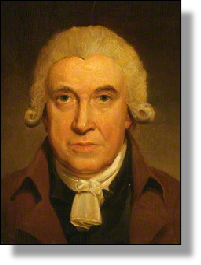 xxxxxAs we have seen, it was in 1712
(AN) that the English engineer Thomas
Newcomen produced his steam engine. Although somewhat crude and
unreliable, it was eventually used to pump water out of mines across
the country, especially in Cornwall. Several years later the
Yorkshireman John Smeaton almost doubled the efficiency of the
engine, and by 1755 it was being exported to North America. It was
left to the Scottish engineer James Watt, however, by a series of
inventions, to turn Newcomen's engine into a highly efficient,
industrial machine, and start the Age of Steam.
xxxxxAs we have seen, it was in 1712
(AN) that the English engineer Thomas
Newcomen produced his steam engine. Although somewhat crude and
unreliable, it was eventually used to pump water out of mines across
the country, especially in Cornwall. Several years later the
Yorkshireman John Smeaton almost doubled the efficiency of the
engine, and by 1755 it was being exported to North America. It was
left to the Scottish engineer James Watt, however, by a series of
inventions, to turn Newcomen's engine into a highly efficient,
industrial machine, and start the Age of Steam.
xxxxxWatt
was born at Greenock, where his father, a local magistrate, had
quite a thriving business building houses and ships. He was trained
as a mathematical instrument maker from the age of 17, and in 1757,
at the age of 21, he opened a small workshop in Glasgow University.
It was during this period that he was asked to repair a Newcomen
engine, and he conjured up some ideas on how it might be improved.
In 1766, however, he took up work
as a canal surveyor, and for the next eight years spent much of his
time in Scotland. Nevertheless in 1769 he took out a patent for "A
New Invented Method of Lessening the Consumption of Steam and Fuel
in Fire Engines."
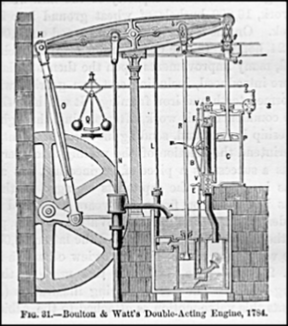
xxxxxItXwas not really until 1775 that, having settled in
Birmingham, he turned a practical hand to manufacturing engines. In
that year he went into partnership with Matthew
Boulton (1728-1809) a local
industrialist of proven technical ability who was anxious to adapt
steam power for factory production. Watt worked at Boulton's Soho
Foundry near Birmingham, and soon made some radical and highly
beneficial changes to Newcomen's basic design. For a start, he
greatly increased economy by incorporating a separate, water-cooled
condenser, thus avoiding the serious loss of steam that occurred
with the constant heating and cooling of the cylinder. And he also
substantially improved efficiency by insulating the cylinder itself,
thereby keeping it at steam temperature.
xxxxxFor
the next five years or so Watt was busy installing his much improved
version of the Newcomen model in tin and copper mines in Cornwall.
During this time, however, he continued his refinement of the
engine, and by 1782 had come up with two
highly significant improvements. Firstly, by admitting steam to both
ends of the cylinder so that the piston was pushed as well as
pulled, he had produced a "double acting engine", as in modern
machines. Secondly, by means of mechanical attachments -
collectively known as "sun-and-planet gearing" - he
had converted this back and forth action into the rotary movement of
a wheel. The effect of this innovation on industry would be
difficult to 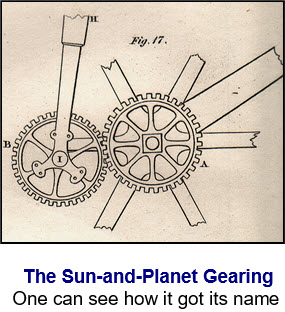 exaggerate.
In the short-term, it replaced waterpower with steam power in
the cotton and woollen mills operating in the north. In the long
term, it meant that a wide variety of factories - such as flour
mills, paper mills, iron mills and distilleries - could now be
mechanised and built near to coal mines for the source of their
power, and close to large towns for the source of their labour
force. Indeed, in 1782 the master potter Josiah
Wedgwood became the first manufacturer to install a steam-powered
engine in his plant at Etruria. The factory system had arrived, and
destined to grow at an alarming rate. Furthermore, this rotative
engine could be employed in canals, waterworks and the like. The
Industrial Revolution was
about to move into its second phase. It is estimated that by the
turn of the century Watt and Boulton had built some 300 of these
engines.
exaggerate.
In the short-term, it replaced waterpower with steam power in
the cotton and woollen mills operating in the north. In the long
term, it meant that a wide variety of factories - such as flour
mills, paper mills, iron mills and distilleries - could now be
mechanised and built near to coal mines for the source of their
power, and close to large towns for the source of their labour
force. Indeed, in 1782 the master potter Josiah
Wedgwood became the first manufacturer to install a steam-powered
engine in his plant at Etruria. The factory system had arrived, and
destined to grow at an alarming rate. Furthermore, this rotative
engine could be employed in canals, waterworks and the like. The
Industrial Revolution was
about to move into its second phase. It is estimated that by the
turn of the century Watt and Boulton had built some 300 of these
engines.
xxxxxNotxsurprisingly, by 1790 Watt was a wealthy man, and
honoured for his achievements. Hexand
Boulton were elected fellows of the Royal Society in 1785, and both
were prominent members of the Birmingham
Lunar Society, so named because it met
monthly at the full moon. This highly influential organisation was
formed in 1766 to promote science and industry, and included among
its members the chemist Joseph Priestly, the pottery manufacturer
Josiah Wedgwood, and the physician and poet Erasmus Darwin. Watt
went into semi-retirement in 1790, but in 1802, following the
signing of the Peace of Amiens, he and his wife travelled in France
and Germany.
xxxxxIncidentally, it was Watt who first used the term "horse power" as a
measure of power. He employed it to compare the power of the steam
engine with that of a horse, though, in fact, he exaggerated the
pulling power of the horse by some 50 percent. The unit of
electrical power - which is linked to horsepower - was
named after him.
Acknowledgements
Watt: oil on wooden panel, by
the English painter Henry Howard (1769-1847), c1797 – National
Portrait Gallery, London. Engine: diagram
contained in The Development of the Modern Steam
Engine by James Watt and his Contemporaries by the American
engineer Robert H. Thurston (1839-1903). Gearing:
diagram contained in The Steam Engine Familiarly
Explained and Illustrated by the Irish scientific writer
Dionysius Lardner (1793-1859), published 1852. Wilkinson: by the English portrait painter Lemuel Francis Abbott
(c1760-1802) – Wrexham County Borough Museum and Archives,
North Wales, UK. Cannon: artist unknown,
diagram contained in A Popular History of
American Invention by the
American science writer Waldemar Kaempffert (1877-1956),
published in 1924. Roebuck: engraving by
Daniel J. Pound (active 1842-1877) after a photograph by John
Jabez Edwin Paisley Mayall, contained in The
Drawing-Room Portrait Gallery of Eminent Personages,
published in The Illustrated News of the World,
London, 1860 – private collection.
G3a-1760-1783-G3a-1760-1783-G3a-1760-1783-G3a-1760-1783-G3a-1760-1783-G3a
Including:
John
Wilkinson

xxxxxThe English ironmaster John Wilkinson (1728-1808)
played an essential part in the making of Watt's ultimate engine. In
1774 he had produced a highly efficient machine for boring the
barrels of cannons. This was adapted to assist Watt in the making of
his much improved cylinder. As Watt's design for this vital part
required a high degree of precision work it could not have been
produced, in fact, without Wilkinson's extraordinary piece of tool
machinery. As we shall see, machine tools of this kind of quality
were later to be developed by such British precision engineers as
Henry Maudslay, James Nasmyth and Joseph Whitworth. Wilkinson also designed a furnace with
enabled pig iron to be re-melted - thus enabling foundries
to be built away from production sites - and it was at his
works at Broseley, Shropshire, that he produced castings for the
iron bridge built by Abraham Darby in 1779, and pipework and fittings for the Paris waterworks. He
was also the first engineer to make an iron-hulled barge,
considered necessary to transport the heavy military equipment he
was making for the government.
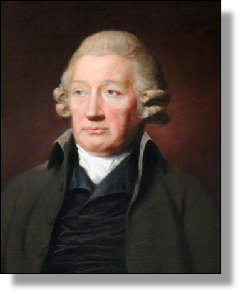 xxxxxThe Englishman John Wilkinson (1728-1808), known at large as "the great
Staffordshire ironmaster", played an essential part in the making of
Watt's ultimate engine - a fact not always recognised. In 1774,
working at his father's factory at Bersham, Denbigh, in Wales, he
produced a highly efficient machine for boring the barrels of
cannons (illustrated below). Regarded today as one of the first
examples of a machine tool, this was adapted to assist Watt in the
making of his much improved cylinder. As Watt's design for this
valuable part required a high degree of precision work, it could not
have been produced, in fact, without the use of Wilkinson's
extraordinary piece of tool machinery. Watt's revolutionary engine
of the 1780s, which, via its boost to the factory system,
accelerated the Industrial Revolution, would certainly not have made
its appearance so early in the day had Wilkinson not been around at
the time! As we shall see, machine tools of this kind of quality
were later to be developed by such British precision engineers as
Henry Maudslay, James Nasmyth and Joseph Whitworth.
xxxxxThe Englishman John Wilkinson (1728-1808), known at large as "the great
Staffordshire ironmaster", played an essential part in the making of
Watt's ultimate engine - a fact not always recognised. In 1774,
working at his father's factory at Bersham, Denbigh, in Wales, he
produced a highly efficient machine for boring the barrels of
cannons (illustrated below). Regarded today as one of the first
examples of a machine tool, this was adapted to assist Watt in the
making of his much improved cylinder. As Watt's design for this
valuable part required a high degree of precision work, it could not
have been produced, in fact, without the use of Wilkinson's
extraordinary piece of tool machinery. Watt's revolutionary engine
of the 1780s, which, via its boost to the factory system,
accelerated the Industrial Revolution, would certainly not have made
its appearance so early in the day had Wilkinson not been around at
the time! As we shall see, machine tools of this kind of quality
were later to be developed by such British precision engineers as
Henry Maudslay, James Nasmyth and Joseph Whitworth.

xxxxxHaving
played so vital a role in its production, Wilkinson used the first
steam engine built by Watt to drive a large air pump at his blast
furnace at Broseley, Shropshire. He specially designed this furnace
to re-melt pig iron, an invention which meant that foundries
need not be established close to the production site. And it was
from here that he supplied many of the castings used in the
construction of the first iron bridge, built by Abraham Darby III in
1779. In later
years he made all the pipework and fittings for the Paris
waterworks, and was responsible for the building of a revolutionary
iron-hulled barge, which he used to transport the heavy
military equipment he was making for the government. And,
ironically, he also taught the
French how to bore cannon from solid castings!
xxxxxIncidentally, Wilkinson took his skills as an ironmaster with him to
the grave. He was buried in a cast-iron coffin, made to his own
design! …..
xxxxx……
The portrait of Wilkinson (illustrated
above) was the work of the English painter
Lemuel Francis Abbott, an artist especially remembered for his
portraits of Lord Nelson. ……
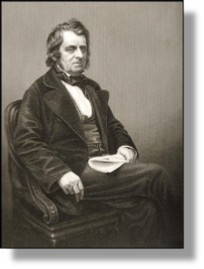
xxxxx…… Andxanother ironmaster who
assisted Watt was the inventor John Roebuck
(1718-1794). He was in partnership with the Scottish engineer
for a short time during the 1770s, when he was working on his
improved version of the Newcomen model. Today, however, Roebuck is
mostly remembered for inventing the means of manufacturing sulphuric
acid on an industrial scale - introduced around 1746 - and
for the various improvements he made at his ironworks at Carron in
Stirlingshire, during the 1760s, including the conversion of cast
iron into malleable iron by means of “a hollow pit-coal fire”.






 xxxxxAs we have seen, it was in 1712
(AN) that the English engineer Thomas
Newcomen produced his steam engine. Although somewhat crude and
unreliable, it was eventually used to pump water out of mines across
the country, especially in Cornwall. Several years later the
Yorkshireman John Smeaton almost doubled the efficiency of the
engine, and by 1755 it was being exported to North America. It was
left to the Scottish engineer James Watt, however, by a series of
inventions, to turn Newcomen's engine into a highly efficient,
industrial machine, and start the Age of Steam.
xxxxxAs we have seen, it was in 1712
(AN) that the English engineer Thomas
Newcomen produced his steam engine. Although somewhat crude and
unreliable, it was eventually used to pump water out of mines across
the country, especially in Cornwall. Several years later the
Yorkshireman John Smeaton almost doubled the efficiency of the
engine, and by 1755 it was being exported to North America. It was
left to the Scottish engineer James Watt, however, by a series of
inventions, to turn Newcomen's engine into a highly efficient,
industrial machine, and start the Age of Steam.
 exaggerate.
In the short-
exaggerate.
In the short-
 xxxxxThe Englishman John Wilkinson (1728-
xxxxxThe Englishman John Wilkinson (1728-



